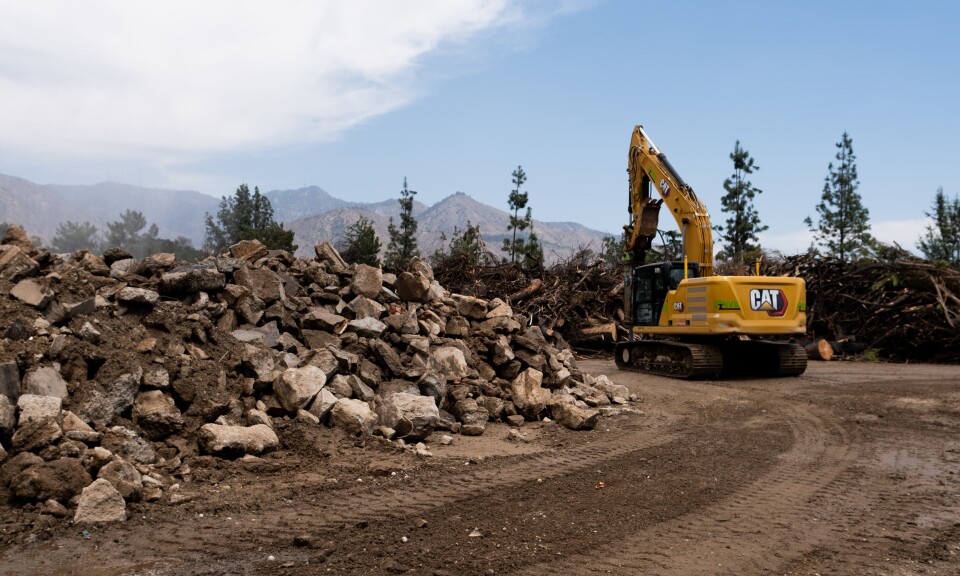This story is free to read because readers choose to support LAist. If you find value in independent local reporting, make a donation to power our newsroom today.
The LA fires left behind millions of tons of debris, some of it toxic. Where does it all go?

For more than two months, the U.S. Army Corp of Engineers has been leading efforts to clear properties damaged in the Eaton and Palisades fires to prepare them for rebuilding.
The operation includes scraping the top six inches of soil and ash, cutting down damaged trees, removing concrete walls and foundations compromised by heat and pulling gnarled melted metal for recycling.

The Army Corps estimates that across nearly 14,000 parcels, as much as 4.5 million tons of material will be removed by the time operations wrap up (hopefully) in the fall. This is the largest municipal wildfire cleanup operation in recent history. For comparison, the deadly 2023 fires in Hawaii generated roughly 400,000 tons of debris.
The Army Corps is using 18 facilities. The Simi Valley, Calabasas and El Sobrante landfills are receiving fire debris and soil, while material containing asbestos goes to the Azusa landfill. If you're curious about where material is headed and how it gets there, you can view a full list of locations and hauling routes from the Eaton and Palisades burn areas.

Ash, soil and debris too hazardous to be recycled — an estimated 80% of the material — is packed up in trucks, wrapped in 10 millimeter plastic and sent to nearby landfills where it’s dumped, spread and covered with dirt each day.
Recyclable concrete, metal and trees, on the other hand, are sent to separation sites in Temescal Canyon and the Altadena Golf Course.

LAist visited the golf course to get a better understanding of the massive and ongoing cleanup operation.
How recyclable material is processed
Trucks enter the facility, pull onto a scale and then dump material in the appropriate piles.


Metal gets separated out and sent to recyclers in Irwindale and El Monte. The material and the dirt the trucks are driving on is wetted to keep dust down.

Trees are dropped into a 15-foot-tall pile that gets shredded and turned into mulch for yards throughout the region.

Concrete chunks are ground up into smaller bits to make for more efficient transport to a recycling facility in Sun Valley. Ultimately, the material may be used for building roads or other applications.

“The whole point of this debris removal operation is to get it off the properties into a consolidated state,” said Cory Koger, debris subject matter expert with the Army Corps. He said that instead of 45 minutes one way, each truck's trip is shortened to eight minutes. And that by processing the material into smaller bits at the separation sites, it could cut the number of truckloads from 150,000 to 75,000 over the course of cleanup operations.
Residents are concerned
Residents who live near the golf course are angry that cleanup operations are so close.
"This is a safety issue. Not a NIMBY issue. Because this would not be safe in any neighborhood," said George Gund, who lives a block away. "It just seems common sense. Inherently there are some risks associated with being this close to a toxic waste facility."
Grinding concrete can release large amount of silica dust, which can float through the air before settling. While the material that is ground is reportedly washed before it’s taken to Altadena Golf Course, residents including Gund are concerned that that process isn't enough to stop other hazardous material, including heavy metals and asbestos, from flying through the air and landing on their properties.
The L.A. County Department of Public Health is still warning that those within 250 yards of fire debris, ash and soot may be exposed to asbestos, particulate matter, heavy metals and hazardous chemicals, potentially leading to both short and long term health effects.
The Board of Supervisors this week approved the use of funds to test for lead on properties not immediately impacted by the Eaton Fire, particularly those downwind, after lead was found in soil samples a mile from the burn area.
"If it's safe, show me the data that says it's safe," said Gund.

Koger acknowledged the concerns.
" We understand that there's people that still live in this neighborhood. We don't want to have an impact to them as well,” Koger said. “ I think we just need to ask the surrounding community to be patient with us. We're doing it as quickly, but as safely as we can."
Dust mitigation measures are in place at the golf course. Material is constantly being wetted, as are the roads that the trucks drive on. Air quality monitors, which you can view live online, have been placed around the golf course. They test for all particulate matter 10 micrometers in size and less (PM 2.5 and PM 10) and not specifically for lead or other harmful materials.
When the levels — which are set to half of the national ambient air quality standards — are exceeded, alarms go off.
The morning LAist visited, the alarms were triggered by crews chipping wood, according to Trevor Durning, an air monitoring technician for Tetra Tech, which is responsible for the monitoring equipment.
Depending on why alarms are triggered, crews may increase the amount of water on a pile or stop operations until the dust settles.

Useful links
- Up-to-date status of removal and cleanup posted by the Army Corp of Engineers.
- Air quality monitors at Altadena Golf Course.
- Air quality monitoring for the burned areas by the South Coast Air Quality Management District.
- Daily dust monitoring report for the Pacific Palisades separation site.











